Textures and Chemical Compositions of Magnetite from Zhibo Submarine Volcanic Iron Oxide Deposit, Xinjiang, China: Implications for Re-Equilibration Processes
Abstract
1. Introduction
2. Geological Setting
2.1. Geology of Western Tianshan
2.2. Geology of the Zhibo Iron Ore Deposit
2.3. Ore Types and Paragenetic Sequence
3. Sample and Method
4. Results
4.1. Petrography and Texture of Magnetite
4.2. Major Element Composition of Magnetite
4.3. Trace Element Composition of Magnetite
5. Discussion
5.1. Constrains on Texture and Composition of Magnetite
5.2. Magmatic or Hydrothermal Origin
6. Conclusions
Supplementary Materials
Author Contributions
Funding
Data Availability Statement
Acknowledgments
Conflicts of Interest
References
- Shen, P.; Pan, H.D.; Li, C.H.; Feng, H.X.; Wu, Y.; Shi, F.P.; Guo, X.C.; Li, W.G. Carboniferous ore-controlling volcanic apparatus and metallogenic models for the large-scale iron deposits in the Western Tianshan, Xinjiang. Acta Petrol. Sin. 2020, 36, 2845–2868, (In Chinese with English Abstract). [Google Scholar] [CrossRef] [PubMed]
- Zhu, Y.; Guo, X.; Song, B.; Zhang, L.; Gu, L. Petrology, Sr-Nd-Hf isotopic geochemistry and zircon chronology of the Late Palaeozoic volcanic rocks in the southwestern Tianshan Mountains, Xinjiang, NW China. J. Geol. Soc. 2009, 66, 1085–1099. [Google Scholar] [CrossRef]
- Zhang, Z.; Hou, T.; Santosh, M.; Li, H.; Li, J.; Zhang, Z.; Song, X.; Wang, M. Spatio-temporal distribution and tectonic settings of the major iron deposits in China: An overview. Ore Geol. Rev. 2014, 57, 247–263. [Google Scholar] [CrossRef]
- Yan, S.; Zhou, R.; Niu, H.; Feng, Y.; Nguyen, A.D.; Zhao, Z.; Yang, W.; Dong, Q.; Zhao, J. LA-MC-ICP-MS U-Pb dating of low-U garnets reveals multiple episodes of skarn formation in the volcanic-hosted iron mineralization system, Awulale belt, Central Asia. GSA Bull. 2019, 132, 1031–1045. [Google Scholar] [CrossRef]
- Li, C.; Shen, P.; Zhang, X.; Shi, F.; Feng, H.; Pan, H.; Wu, Y.; Li, W. Mineralogy and mineral chemistry related to the Au mineralization in the Dunde Fe-Zn deposit, western Tianshan. Ore Geol. Rev. 2020, 124, 103650. [Google Scholar] [CrossRef]
- Xiao, W.; Kusky, T. Geodynamic processes and metallogenesis of the Central Asian and related orogenic belts: Introduction. Gondwana Res. 2009, 16, 167–169. [Google Scholar] [CrossRef]
- Dong, L.H.; Feng, J.; Zhuang, D.Z.; Li, F.M.; Qu, X.; Liu, D.Q.; Tang, Y.L. Discussion of metallogenic models, mineralization characteristic and main type of rich iron ore of Xinjiang. Xinjiang Geol. 2012, 29, 416–422, (In Chinese with English Abstract). [Google Scholar]
- Gao, J.; Long, L.L.; Klemd, R.; Qian, Q.; Liu, D.Y.; Xiong, X.M.; Su, W.; Liu, W.; Wang, Y.T.; Yang, F.Q. Tectonic evolution of the South Tianshan orogen and adjacent regions, NW China: Geochemical and age constraints of granitoid rocks. Int. J. Earth Sci. 2009, 98, 1221–1238. [Google Scholar] [CrossRef]
- Zhang, X.; Tian, J.; Gao, J.; Klemd, R.; Dong, L.; Fan, J.; Jiang, T.; Hu, C.; Qian, Q. Geochronology and geochemistry of granitoid rocks from the Zhibo syngenetic volcanogenic iron ore deposit in the Western Tianshan Mountains (NW-China): Constraints on the age of mineralization and tectonic setting. Gondwana Res. 2012, 22, 585–596. [Google Scholar] [CrossRef]
- Luo, W.; Zhang, Z.; Duan, S.; Jiang, Z.; Wang, D.; Chen, J.; Sun, J.; Santosh, M. Geochemistry of the Zhibo submarine intermediate-mafic volcanic rocks and associated iron ores, Western Tianshan, Northwest China: Implications for ore genesis. Geol. J. 2018, 53, 3147–3172. [Google Scholar] [CrossRef]
- Yan, S.; Niu, H.C.; Zhao, J.X.; Bao, Z.W.; Sun, W.D. Ore-fluid geochemistry and metallogeny of the Dunde iron–zinc deposit in western Tianshan, Xinjiang, China: Evidence from fluid inclusions, REE and C–O–Sr isotopes of calcite. Ore Geol. Rev. 2018, 100, 441–456. [Google Scholar] [CrossRef]
- Zhang, X.; Klemd, R.; Gao, J.; Dong, L.H.; Wang, X.S.; Haase, K.; Jiang, T.; Qian, Q. Metallogenesis of the Zhibo and Chagangnuoer volcanic iron oxide deposits in the Awulale Iron Metallogenic Belt, Western Tianshan orogen, China. J. Asian Earth Sci. 2015, 113, 151–172. [Google Scholar] [CrossRef]
- Sun, W.; Niu, Y.; Ma, Y.; Liu, Y.; Zhang, G.; Hu, Z.; Zhang, Z.; Chen, S.; Li, J.; Wang, X. Petrogenesis of the Chagangnuoer deposit, NW China: A general model for submarine volcanic-hosted skarn iron deposits. Sci. Bull. 2015, 60, 363–379. [Google Scholar] [CrossRef]
- Yang, X.; Liang, T.; Guo, X.; Zheng, Y.; Zhou, Y.; Chen, Z.; Somerville, I.D. Mineralogy and stable isotope constraints on the genesis of submarine volcanic-hosted Beizhan iron deposit in the Western Tianshan, NW China. Geol. J. 2018, 53, 329–344. [Google Scholar] [CrossRef]
- Yang, X.; Mao, J.; Zhang, Z.; Robbins, L.J.; Planavsky, N.J.; Jiang, Z.; Duan, S.; Chen, Z. Episodic ferruginous conditions associated with submarine volcanism led to the deposition of a Late Carboniferous iron formation. Geochim. Cosmochim. Acta 2021, 292, 1–23. [Google Scholar] [CrossRef]
- Hou, T.; Zhang, Z.; Pirajno, F.; Santosh, M.; Encarnacion, J.; Liu, J.; Zhao, Z.; Zhang, L. Geology, tectonic settings and iron ore metallogenesis associated with submarine volcanism in China: An overview. Ore Geol. Rev. 2014, 57, 498–517. [Google Scholar] [CrossRef]
- Huang, X.W.; Beaudoin, G. Textures and Chemical Compositions of Magnetite from Iron Oxide Copper-Gold (IOCG) and Kiruna-Type Iron Oxide-Apatite (IOA) Deposits and Their Implications for Ore Genesis and Magnetite Classification Schemes. Econ. Geol. 2019, 114, 953–979. [Google Scholar] [CrossRef]
- Knipping, J.L.; Fiege, A.; Simon, A.C.; Oeser, M.; Reich, M.; Bilenker, L.D. In-situ iron isotope analyses reveal igneous and magmatic-hydrothermal growth of magnetite at the Los Colorados Kiruna-type iron oxide-apatite deposit, Chile. Am. Mineral. 2019, 104, 471–484. [Google Scholar] [CrossRef]
- Xie, Q.; Zhang, Z.; Jin, Z.; Santosh, M.; Han, L.; Wang, K.; Zhao, P.; He, H. The high-grade Fe skarn deposit of Jinling, North China Craton: Insights into hydrothermal iron mineralization. Ore Geol. Rev. 2021, 138, 104395. [Google Scholar] [CrossRef]
- Tornos, F.; Velasco, F.; Hanchar, J.M. Iron-rich melts, magmatic magnetite, and superheated hydrothermal systems: The El Laco deposit, Chile. Geology 2016, 44, 427–430. [Google Scholar] [CrossRef]
- Tornos, F.; Velasco, F.; Hanchar, J.M. The Magmatic to Magmatic-Hydrothermal Evolution of the El Laco Deposit (Chile) and Its Implications for the Genesis of Magnetite-Apatite Deposits. Econ. Geol. 2017, 112, 1595–1628. [Google Scholar] [CrossRef]
- Günther, T.; Klemd, R.; Zhang, X.; Horn, I.; Weyer, S. In-situ trace element and Fe-isotope studies on magnetite of the volcanic-hosted Zhibo and Chagangnuoer iron ore deposits in the Western Tianshan, NW China. Chem. Geol. 2017, 453, 111–127. [Google Scholar] [CrossRef]
- Wang, Z.H.; Zhang, Z.H.; Jiang, Z.S.; Hong, W.; Tian, J.Q. Magnetite composition of Zhibo iron deposit in Western Tianshan Mountains and its genetic significance. Miner. Depos. 2012, 31, 983–998, (In Chinese with English Abstract). [Google Scholar]
- Wang, Z.H.; Hou, L.; Gao, Y.W.; Zhang, Z.L.; Jiang, Z.S.; Zhang, Z.H. Geochemical characteristics and oxygen isotopes of magnetites in Zhibo iron deposit, Western Tianshan. Acta Petrol. Sin. 2018, 34, 2312–2326, (In Chinese with English Abstract). [Google Scholar]
- Wang, Z.H.; Hou, L.; Gao, Y.W.; Zhang, Z.L.; Jiang, Z.S.; Zhang, Z.H. Chemical composition and sulfur isotope of pyrite from Zhibo iron ore deposit in Western Tianshan Mountains. Miner. Depos. 2018, 37, 176–193, (In Chinese with English Abstract). [Google Scholar]
- Velasco, F.; Tornos, F.; Hanchar, J.M. Immiscible iron- and silica-rich melts and magnetite geochemistry at the El Laco volcano (northern Chile): Evidence for a magmatic origin for the magnetite deposits. Ore Geol. Rev. 2016, 79, 346–366. [Google Scholar] [CrossRef]
- Larrañaga, A.; Briezewski, T.; Tornos, F.; de la Pinta, N.; Velasco, F. The relationship of destinezite to the acid sulfate alteration at the El Laco magnetite deposit, Chile. Am. Mineral. 2020, 105, 860–872. [Google Scholar] [CrossRef]
- Jiang, Z.; Zhang, Z.; Wang, Z.; Duan, S.; Li, F.; Tian, J. Geology, geochemistry, and geochronology of the Zhibo iron deposit in the Western Tianshan, NW China: Constraints on metallogenesis and tectonic setting. Ore Geol. Rev. 2014, 57, 406–424. [Google Scholar] [CrossRef]
- Shcheka, S.A.; Platkov, A.V.; Vrzhosek, A.A.; Levashov, G.B.; Oktyabrsky, R.A. The trace element paragenesis of magnetite. Nauka Mosc. 1980, 147. [Google Scholar]
- Wen, G.; Deng, X.-D.; Zhou, R.-J.; Duan, Z.; Cui, B.-Z.; Li, J.-W. Geology, geochronology and stable isotope studies at the Baijian Fe-(Co) skarn deposit, eastern China, with implications for ore genesis and regional Fe skarn metallogeny. Ore Geol. Rev. 2024, 166, 105935. [Google Scholar] [CrossRef]
- Rodriguez-Mustafa, M.A.; Simon, A.C.; del Real, I.; Thompson, J.F.H.; Bilenker, L.D.; Barra, F.; Bindeman, I.; Cadwell, D. A Continuum from Iron Oxide Copper-Gold to Iron Oxide-Apatite Deposits: Evidence from Fe and O Stable Isotopes and Trace Element Chemistry of Magnetite. Econ. Geol. 2020, 115, 1443–1459. [Google Scholar] [CrossRef]
- Canil, D.; Lacourse, T. Geothermometry using minor and trace elements in igneous and hydrothermal magnetite. Chem. Geol. 2020, 541, 119576. [Google Scholar] [CrossRef]
- Rojas, P.A.; Barra, F.; Reich, M.; Deditius, A.; Simon, A.; Uribe, F.; Romero, R.; Rojo, M. A genetic link between magnetite mineralization and diorite intrusion at the El Romeral iron oxide-apatite deposit, northern Chile. Miner. Depos. 2018, 53, 947–966. [Google Scholar] [CrossRef]
- Nadoll, P.; Angerer, T.; Mauk, J.L.; French, D.; Walshe, J. The chemistry of hydrothermal magnetite: A review. Ore Geol. Rev. 2014, 61, 1–32. [Google Scholar] [CrossRef]
- Bédard, É.; Hébert, R.; Guilmette, C.; Lesage, G.; Wang, C.S.; Dostal, J. Petrology and geochemistry of the Saga and Sangsang ophiolitic massifs, Yarlung Zangbo Suture Zone, Southern Tibet: Evidence for an arc–back-arc origin. Lithos 2009, 113, 48–67. [Google Scholar] [CrossRef]
- Wen, G.; Li, J.-W.; Hofstra, A.H.; Koenig, A.E.; Lowers, H.A.; Adams, D. Hydrothermal reequilibration of igneous magnetite in altered granitic plutons and its implications for magnetite classification schemes: Insights from the Handan-Xingtai iron district, North China Craton. Geochim. Cosmochim. Acta 2017, 213, 255–270. [Google Scholar] [CrossRef]
- Dupuis, C.; Beaudoin, G. Discriminant diagrams for iron oxide trace element fingerprinting of mineral deposit types. Miner. Depos. 2011, 46, 319–335. [Google Scholar] [CrossRef]
- McClenaghan, M.B. Indicator mineral methods in mineral exploration. Geochem. Explor. Environ. Anal. 2005, 5, 233–245. [Google Scholar] [CrossRef]
- Nadoll, P.; Mauk, J.L.; Hayes, T.S.; Koenig, A.E.; Box, S.E. Geochemistry of Magnetite from Hydrothermal Ore Deposits and Host Rocks of the Mesoproterozoic Belt Supergroup, United States. Econ. Geol. 2012, 107, 1275–1292. [Google Scholar] [CrossRef]
- Nadoll, P.; Mauk, J.L.; Leveille, R.A.; Koenig, A.E. Geochemistry of magnetite from porphyry Cu and skarn deposits in the southwestern United States. Miner. Depos. 2014, 50, 493–515. [Google Scholar] [CrossRef]
- Yin, S.; Ma, C.; Robinson, P.T. Textures and high field strength elements in hydrothermal magnetite from a skarn system: Implications for coupled dissolution-reprecipitation reactions. Am. Mineral. 2018, 102, 1045–1056. [Google Scholar] [CrossRef]
- Hu, H.; Lentz, D.; Li, J.W.; McCarron, T.; Zhao, X.F.; Hall, D. Reequilibration Processes in Magnetite from Iron Skarn Deposits. Econ. Geol. 2014, 110, 1–8. [Google Scholar] [CrossRef]
- Hu, X.; Chen, H.; Huang, X.; Zhang, W. Texture and composition of magnetite in the Duotoushan deposit, NW China: Implications for ore genesis of Fe–Cu deposits. Mineral. Mag. 2020, 84, 398–411. [Google Scholar] [CrossRef]
- Knipping, J.L.; Bilenker, L.D.; Simon, A.C.; Reich, M.; Barra, F.; Deditius, A.P.; Lundstrom, C.; Bindeman, I.; Munizaga, R.J.G. Giant Kiruna-type deposits form by efficient flotation of magmatic magnetite suspensions. Geology 2015, 43, 591–594. [Google Scholar] [CrossRef]
- Knipping, J.L.; Bilenker, L.D.; Simon, A.C.; Reich, M.; Barra, F.; Deditius, A.P.; Wälle, M.; Heinrich, C.A.; Holtz, F.; Munizaga, R. Trace elements in magnetite from massive iron oxide-apatite deposits indicate a combined formation by igneous and magmatic-hydrothermal processes. Geochim. Cosmochim. Acta 2015, 171, 15–38. [Google Scholar] [CrossRef]
- Allen, M.B.; Windley, B.F.; Chi, Z. Paleozoic collisional tectonics and magmatism of the Chinese Tien-Shan, Central-Asia. Tectonophysics 1993, 220, 89–115. [Google Scholar] [CrossRef]
- Windley, B.F.; Allen, M.B.; Zhang, C.; Zhao, Z.Y.; Wang, G.R. paleozoic accretion and cenozoic redeformation of the Chinese Tien-Shan-Range, Central-Asia. Geology 1990, 18, 128–131. [Google Scholar] [CrossRef]
- Xiao, W.J.; Han, C.M.; Yuan, C.; Sun, M.; Lin, S.F.; Chen, H.L.; Li, Z.L.; Li, J.L.; Sun, S. Middle Cambrian to Permian subduction-related accretionary orogenesis of Northern Xinjiang, NW China: Implications for the tectonic evolution of central Asia. J. Asian Earth Sci. 2008, 32, 102–117. [Google Scholar] [CrossRef]
- Qian, Q.; Gao, J.; Klemd, R.; He, G.Q.; Song, B.A.; Liu, D.Y.; Xu, R.H. Early Paleozoic tectonic evolution of the Chinese South Tianshan Orogen: Constraints from SHRIMP zircon U-Pb geochronology and geochemistry of basaltic and dioritic rocks from Xiate, NW China. Int. J. Earth Sci. 2009, 98, 551–569. [Google Scholar] [CrossRef]
- Ge, S.; Zhai, M.; Safonova, I.; Li, D.; Zhu, X.; Zuo, P.; Shan, H. Whole-rock geochemistry and Sr-Nd-Pb isotope systematics of the Late Carboniferous volcanic rocks of the Awulale metallogenic belt in the western Tianshan Mountains (NW China): Petrogenesis and geodynamical implications. Lithos 2015, 228–229, 62–77. [Google Scholar] [CrossRef]
- Kroner, A.; Kovach, V.; Alexeiev, D.; Wang, K.L.; Wong, J.; Degtyarev, K.; Kozakov, I. No excessive crustal growth in the Central Asian Orogenic Belt: Further evidence from field relationships and isotopic data. Gondwana Res. 2017, 50, 135–166. [Google Scholar] [CrossRef]
- Wang, B.; Liu, H.S.; Shu, L.S.; Jahn, B.M.; Chung, S.L.; Zhai, Y.Z.; Liu, D.Y. Early Neoproterozoic crustal evolution in northern Yili Block: Insights from migmatite, orthogneiss and leucogranite of the Wenquan metamorphic complex in the NW Chinese Tianshan. Precambrian Res. 2014, 242, 58–81. [Google Scholar] [CrossRef]
- Chen, Y.C.; Liu, D.Q.; Tang, Y.L.; Wang, D.H.; Dong, L.H.; Xu, X.; Wang, X.D. Mineral and Metallogenic Systems in Tianshan, China; Geological Publishing House: Beijing, China, 2008. [Google Scholar]
- Li, J.L.; Su, W.; Zhang, X.; Liu, X. Zircon Cameca U–Pb dating and its significance for granulite-facies granitic gneisses from the west Awulale Mountains, West Tianshan, China. Geol. Bull. China 2009, 28, 1852–1862, (In Chinese with English Abstract). [Google Scholar]
- Feng, J.X.; Shi, F.P.; Wang, B.Y.; Hu, J.M.; Wang, J.T.; Tian, J.Q. The Syngenetic Volcanogenic Iron Ore Deposits in Awulale Metallogenetic Belt Western Tianshan Mountains; Geological Publishing House: Beijing, China, 2010. (In Chinese) [Google Scholar]
- Tian, J.; Li, M.; Xie, R.S.; Peng, W.L.; Xie, W.B.; Yan, R.; Hu, C.J. Resource Verified Reports of the Nuoerhu Iron deposit, Hejing County, Xinjiang; No.3 Geological Brigade of Xinjiang Geology and Mineral Exploration and Development Bureau: Xinjiang, China, 2015; p. 214. (In Chinese) [Google Scholar]
- Jiang, Z.; Wang, D.; Zhang, Z.; Duan, S.; Kang, Y.; Li, F. Application of in situ titanite U–Pb geochronology to volcanic-hosted magnetite deposit: New constraints on the timing and genesis of the Zhibo deposit, Western Tianshan, NW China. Ore Geol. Rev. 2018, 95, 325–341. [Google Scholar] [CrossRef]
- Liu, Y.S.; Hu, Z.C.; Gao, S.; Gunther, D.; Xu, J.; Gao, C.G.; Chen, H.H. In situ analysis of major and trace elements of anhydrous minerals by LA-ICP-MS without applying an internal standard. Chem. Geol. 2008, 257, 34–43. [Google Scholar] [CrossRef]
- Liu, Y.; Gao, S.; Hu, Z.; Gao, C.; Zong, K.; Wang, D. Continental and Oceanic Crust Recycling-induced Melt-Peridotite Interactions in the Trans-North China Orogen: U-Pb Dating, Hf Isotopes and Trace Elements in Zircons from Mantle Xenoliths. J. Petrol. 2009, 51, 537–571. [Google Scholar] [CrossRef]
- Fleet, M.E. The Structure of Magnetite. Acta Crystallogr. Sect. B-Struct. Sci. 1981, 37, 917–920. [Google Scholar] [CrossRef]
- Wechsler, B.A.; Lindsley, D.H.; Prewitt, C.T. crystal-structure and cation distribution in titanomagnetites (fe3-xtixo4). Am. Mineral. 1984, 69, 754–770. [Google Scholar]
- Dare, S.A.S.; Barnes, S.-J.; Beaudoin, G. Variation in trace element content of magnetite crystallized from a fractionating sulfide liquid, Sudbury, Canada: Implications for provenance discrimination. Geochim. Cosmochim. Acta 2012, 88, 27–50. [Google Scholar] [CrossRef]
- Whalen, J.B.; Chappell, B.W.J.A.M. Opaque mineralogy and mafic mineral chemistry of I-and S-type granites of the Lachlan fold belt, southeast Australia. Am. Mineral. 1988, 73, 281–296. [Google Scholar]
- Frost, B.R. Stability of oxide minerals in metamorphic rocks. Rev. Mineral. Geochem. 1991, 25, 469–488. [Google Scholar]
- Ghiorso, M.S.; Sack, O. Fe-Ti oxide geothermometry: Thermodynamic formulation and the estimation of intensive variables in silicic magmas. Contrib. Mineral. Petrol. 1991, 108, 485–510. [Google Scholar] [CrossRef]
- Lindsley, D.H. Experimental studies of oxide minerals. Rev. Mineral. Geochem. 1991, 25, 69–106. [Google Scholar]
- Verdugo-Ihl, M.R.; Ciobanu, C.L.; Cook, N.J.; Ehrig, K.; Slattery, A.; Courtney-Davies, L.; Dmitrijeva, M. Nanomineralogy of hydrothermal magnetite from Acropolis, South Australia: Genetic implications for iron-oxide copper gold mineralization. Am. Mineral. 2021, 106, 1273–1293. [Google Scholar] [CrossRef]
- Rodriguez-Mustafa, M.A.; Simon, A.C.; Bilenker, L.D.; Bindeman, I.; Mathur, R.; Machado, E.L.B. The Mina Justa Iron Oxide Copper-Gold (IOCG) Deposit, Peru: Constraints on Metal and Ore Fluid Sources. Econ. Geol. 2021, 117, 645–666. [Google Scholar] [CrossRef]
- Duran, C.J.; Barnes, S.-J.; Mansur, E.T.; Dare, S.A.S.; Bédard, L.P.; Sluzhenikin, S.F. Magnetite Chemistry by LA-ICP-MS Records Sulfide Fractional Crystallization in Massive Nickel-Copper-Platinum Group Element Ores from the Norilsk-Talnakh Mining District (Siberia, Russia): Implications for Trace Element Partitioning into Magnetite. Econ. Geol. 2020, 115, 1245–1266. [Google Scholar] [CrossRef]
- Putnis, A. Mineral replacement reactions: From macroscopic observations to microscopic mechanisms. Mineral. Mag. 2002, 6, 689–708. [Google Scholar] [CrossRef]
- Putnis, A. Transient Porosity Resulting from Fluid–Mineral Interaction and its Consequences. Rev. Mineral. Geochem. 2015, 80, 1–23. [Google Scholar] [CrossRef]
- Hu, X.; Xiao, B.; Jiang, H.; Huang, J. Magnetite texture and trace element evolution in the Shaquanzi Fe-Cu deposit, Eastern Tianshan, NW China. Ore Geol. Rev. 2023, 154, 105306. [Google Scholar] [CrossRef]
- Canil, D.; Grondahl, C.; Lacourse, T.; Pisiak, L.K. Trace elements in magnetite from porphyry Cu–Mo–Au deposits in British Columbia, Canada. Ore Geol. Rev. 2016, 72, 1116–1128. [Google Scholar] [CrossRef]
- Hou, T.; Charlier, B.; Holtz, F.; Veksler, I.; Zhang, Z.; Thomas, R.; Namur, O. Immiscible hydrous Fe-Ca-P melt and the origin of iron oxide-apatite ore deposits. Nat. Commun. 2018, 9, 1415. [Google Scholar] [CrossRef]
- Mungall, J.E.; Brenan, J.M.; Godel, B.; Barnes, S.J.; Gaillard, F. Transport of metals and sulphur in magmas by flotation of sulphide melt on vapour bubbles. Nat. Geosci. 2015, 8, 216–219. [Google Scholar] [CrossRef]
- Li, W.; Xie, G.; Mao, J.; Zhu, Q.; Zheng, J. Mineralogy, Fluid Inclusion, and Stable Isotope Studies of the Chengchao Deposit, Hubei Province, Eastern China: Implications for the Formation of High-Grade Fe Skarn Deposits. Econ. Geol. 2019, 114, 325–352. [Google Scholar] [CrossRef]
- Taofa, Z.; Mingan, W.; Yu, F.; Chao, D.; Feng, Y.; Lejun, Z.; Jun, L.; Bing, Q.; Pirajno, F.; Cooke, D.R. Geological, geochemical characteristics and isotope systematics of the Longqiao iron deposit in the Lu-Zong volcano-sedimentary basin, Middle-Lower Yangtze (Changjiang) River Valley, Eastern China. Ore Geol. Rev. 2011, 43, 154–169. [Google Scholar] [CrossRef]
- Philpotts, A.R.; Doyle, C.D. Effect of magma oxidation-state on the extent of silicate liquid immiscibility in a tholeiitic basalt. Am. J. Sci. 1983, 283, 967–986. [Google Scholar] [CrossRef]
- Henriquez, F.; Martin, R.F. crystal-growth textures in magnetite flows and feeder dykes, El Laco, Chile. Can. Mineral. 1978, 16, 581–589. [Google Scholar]
- Sillitoe, R.H.; Burrows, D.R. New field evidence bearing on the origin of the El Laco magnetite deposit, northern Chile. Econ. Geol. Bull. Soc. Econ. Geol. 2002, 97, 1101–1109. [Google Scholar] [CrossRef]
- Barra, F.; Reich, M.; Selby, D.; Rojas, P.; Simon, A.; Salazar, E.; Palma, G. Unraveling the origin of the Andean IOCG clan: A Re-Os isotope approach. Ore Geol. Rev. 2017, 81, 62–78. [Google Scholar] [CrossRef]
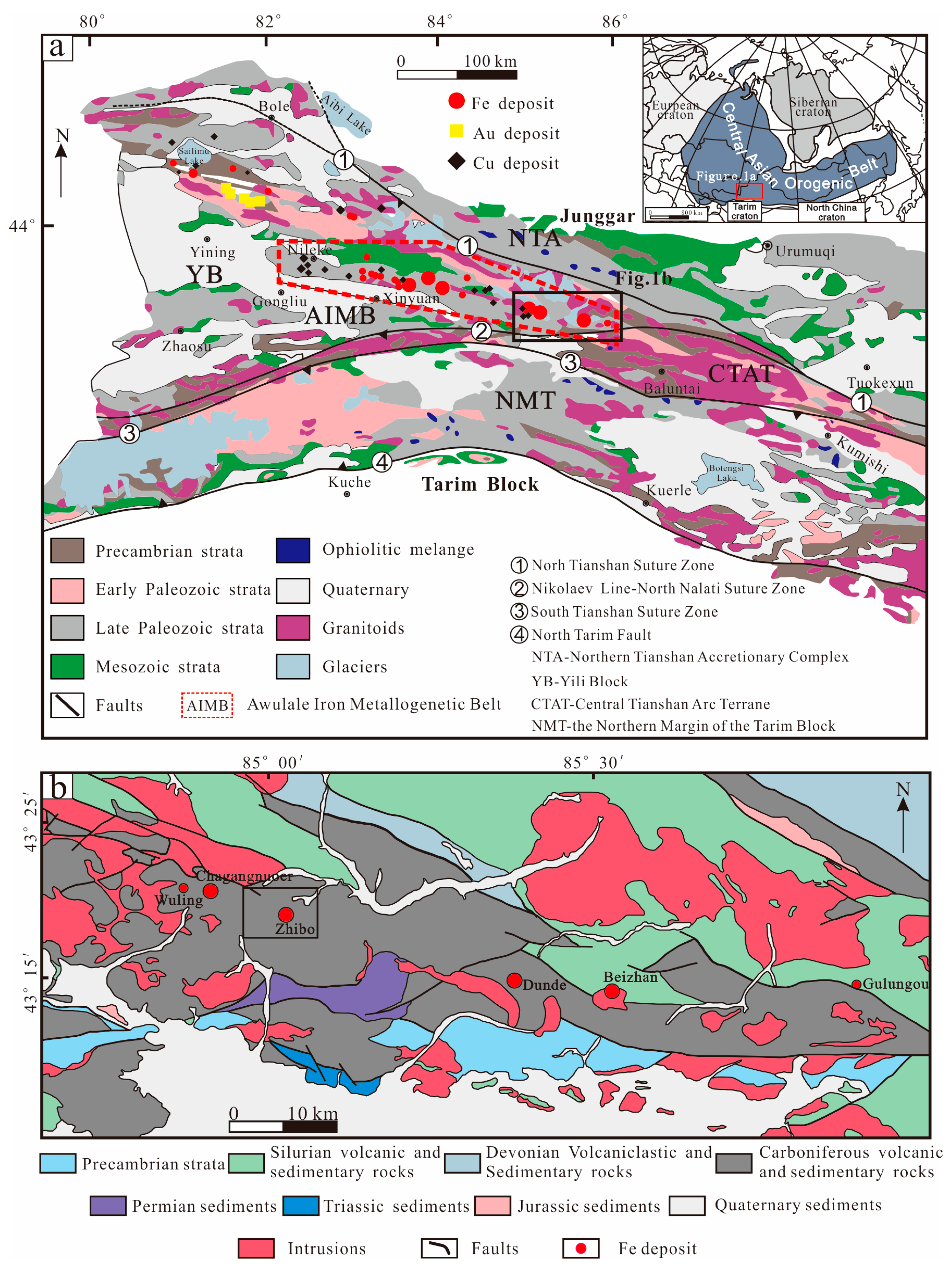
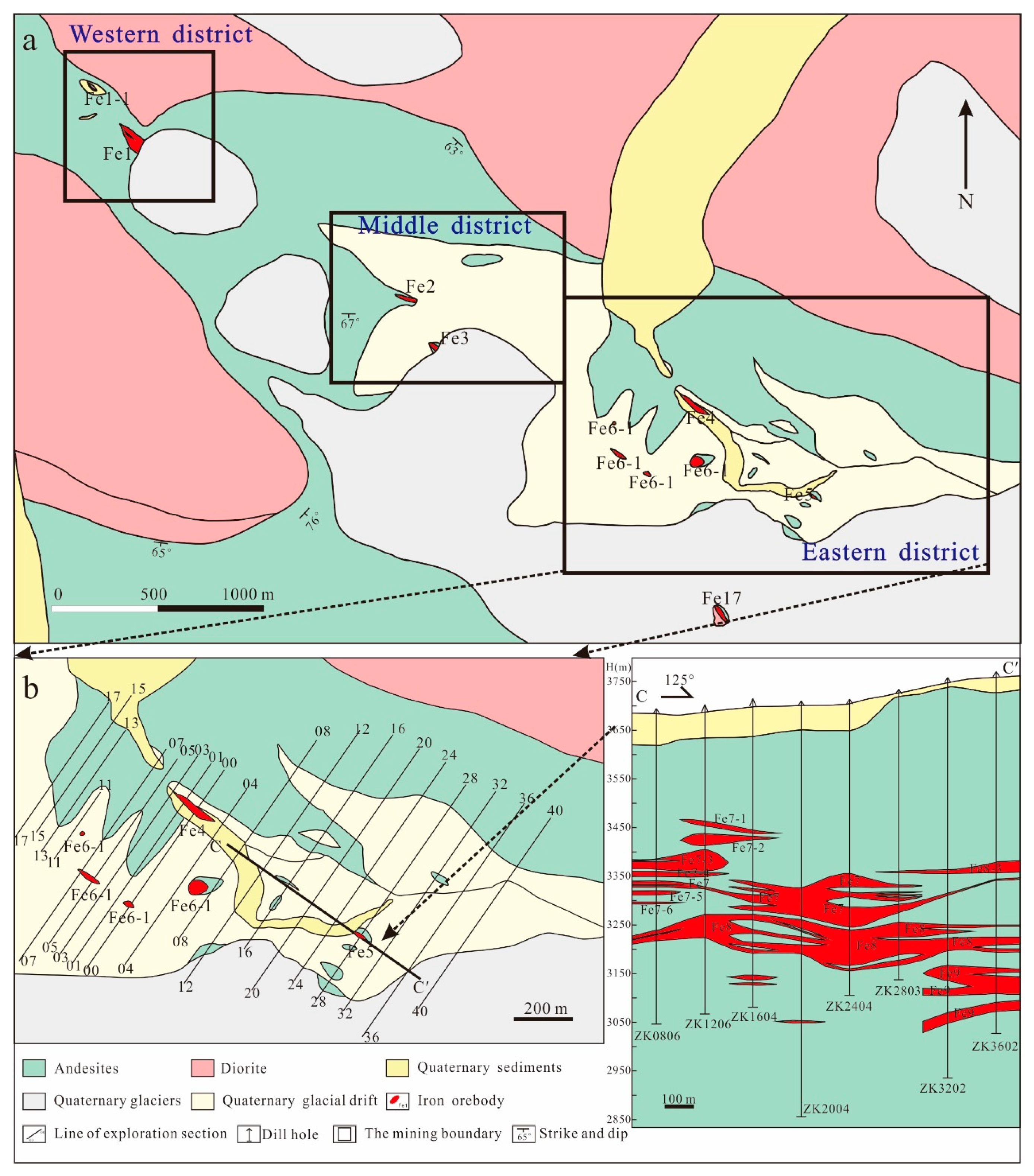
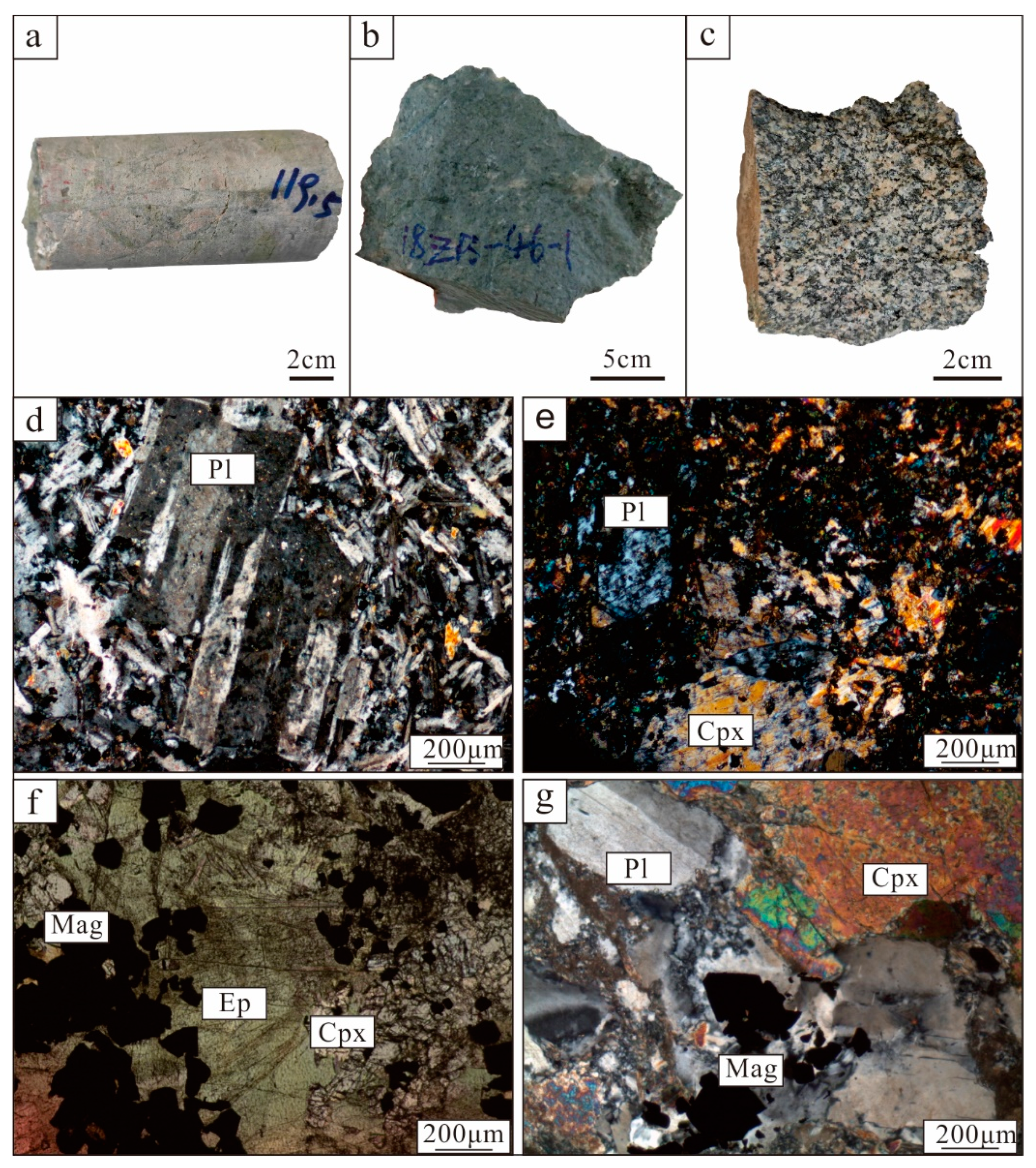
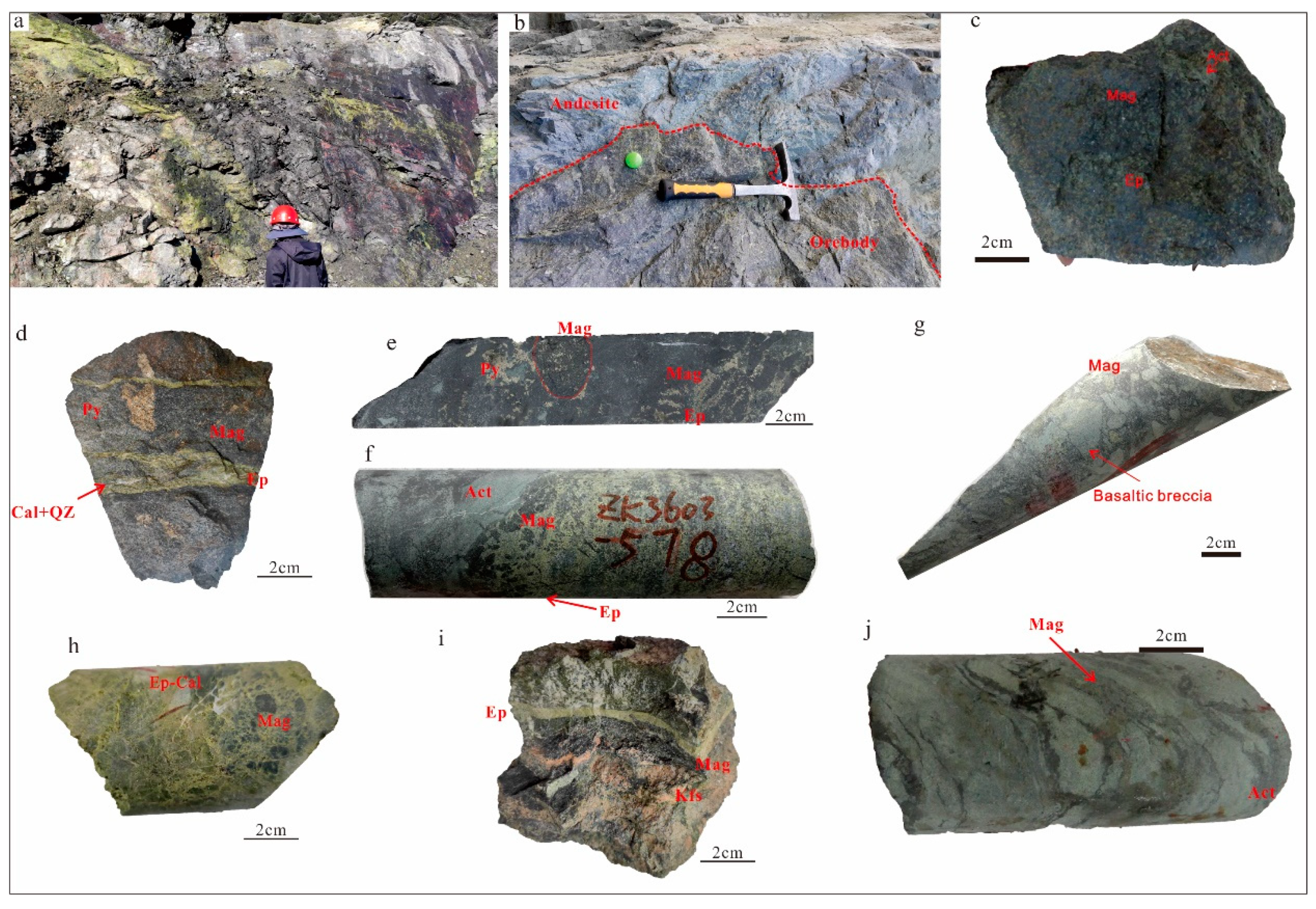
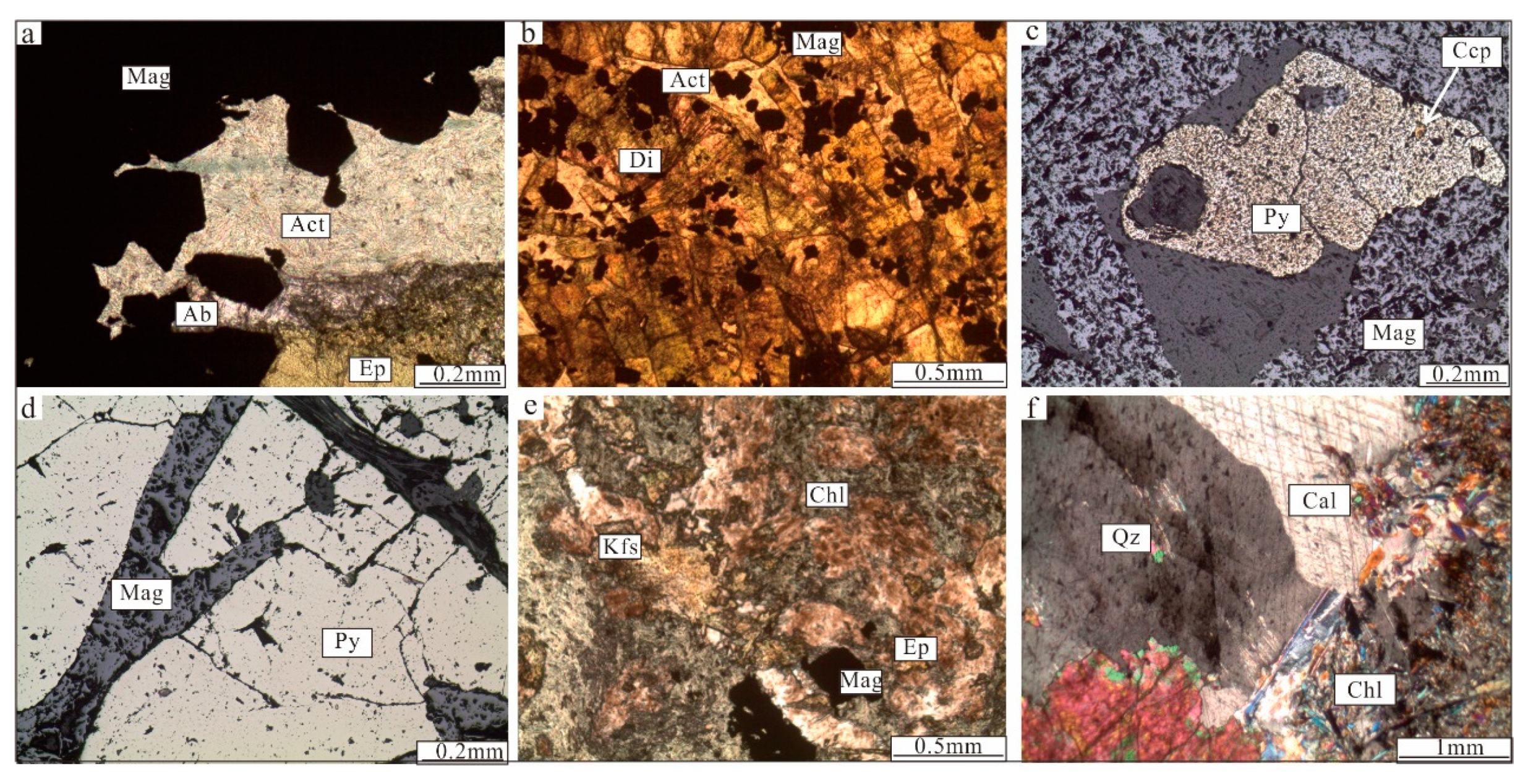
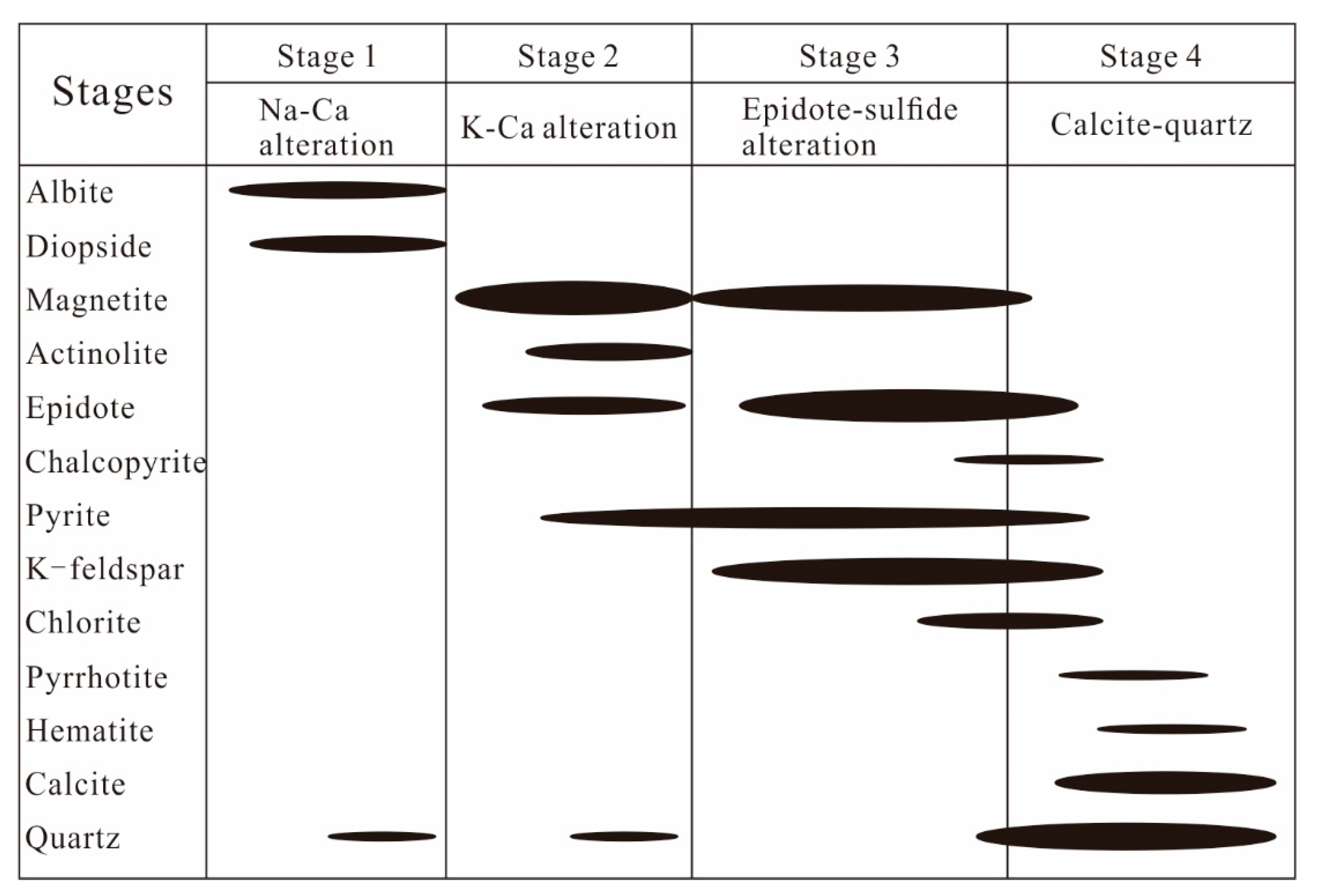
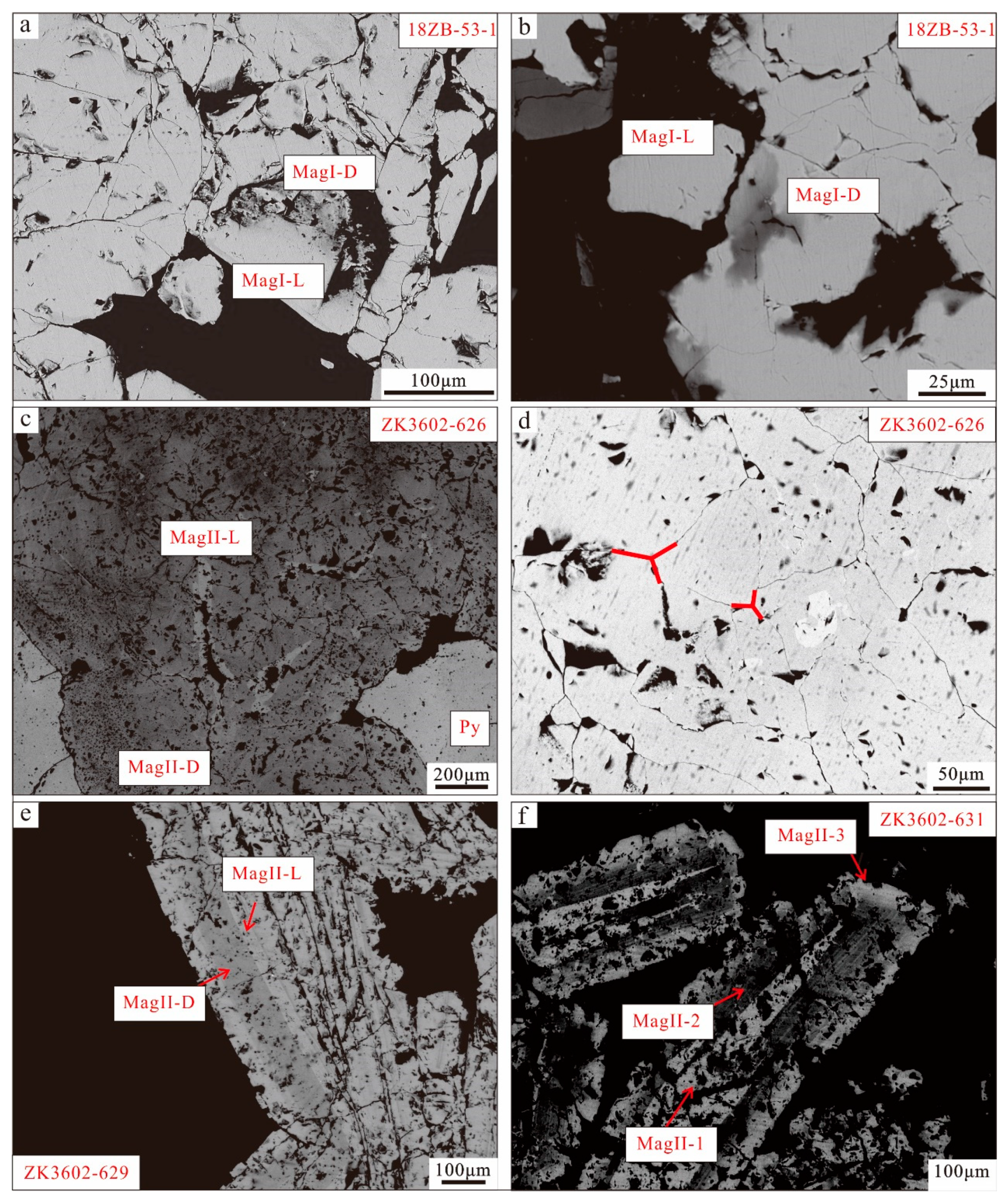
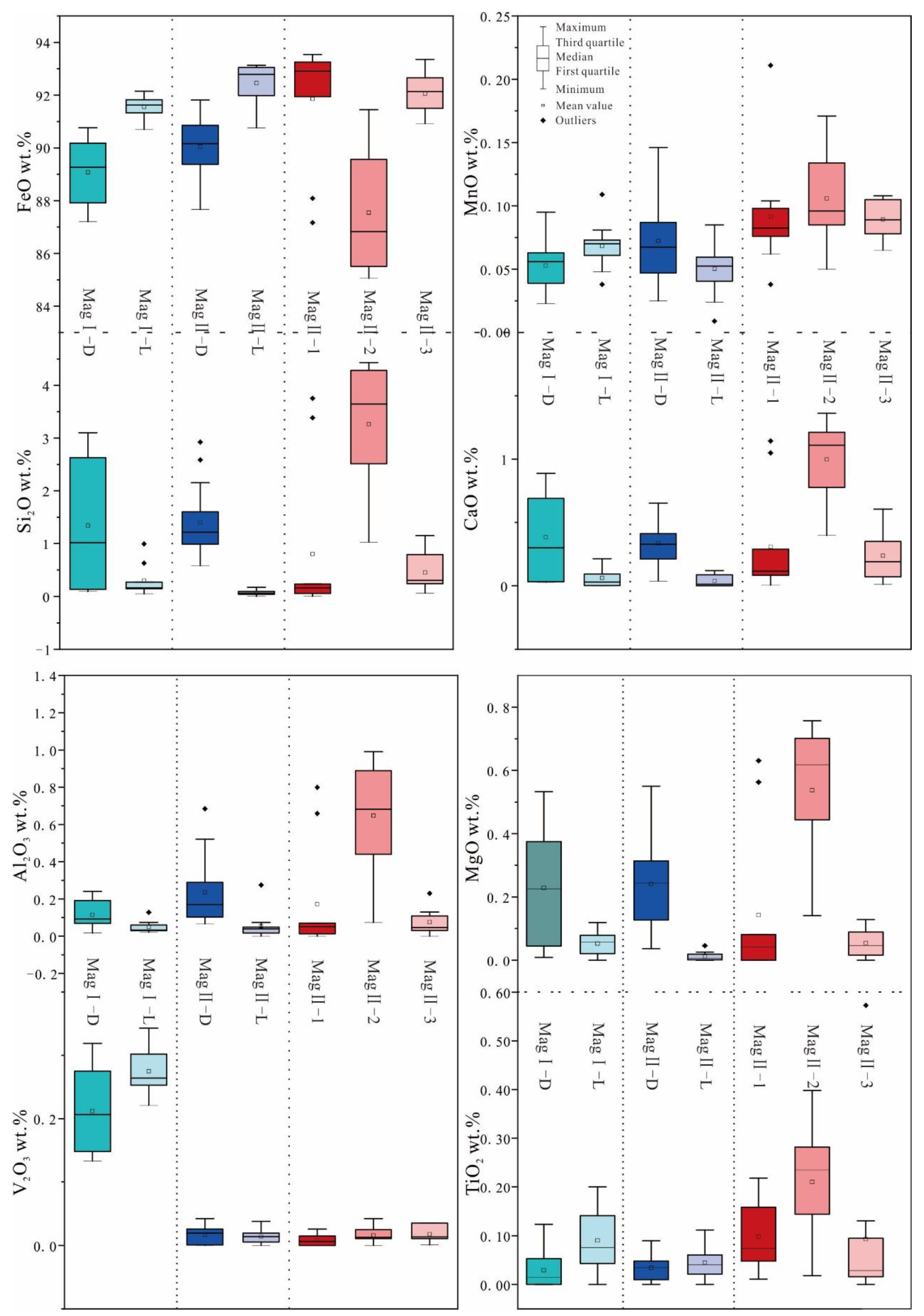

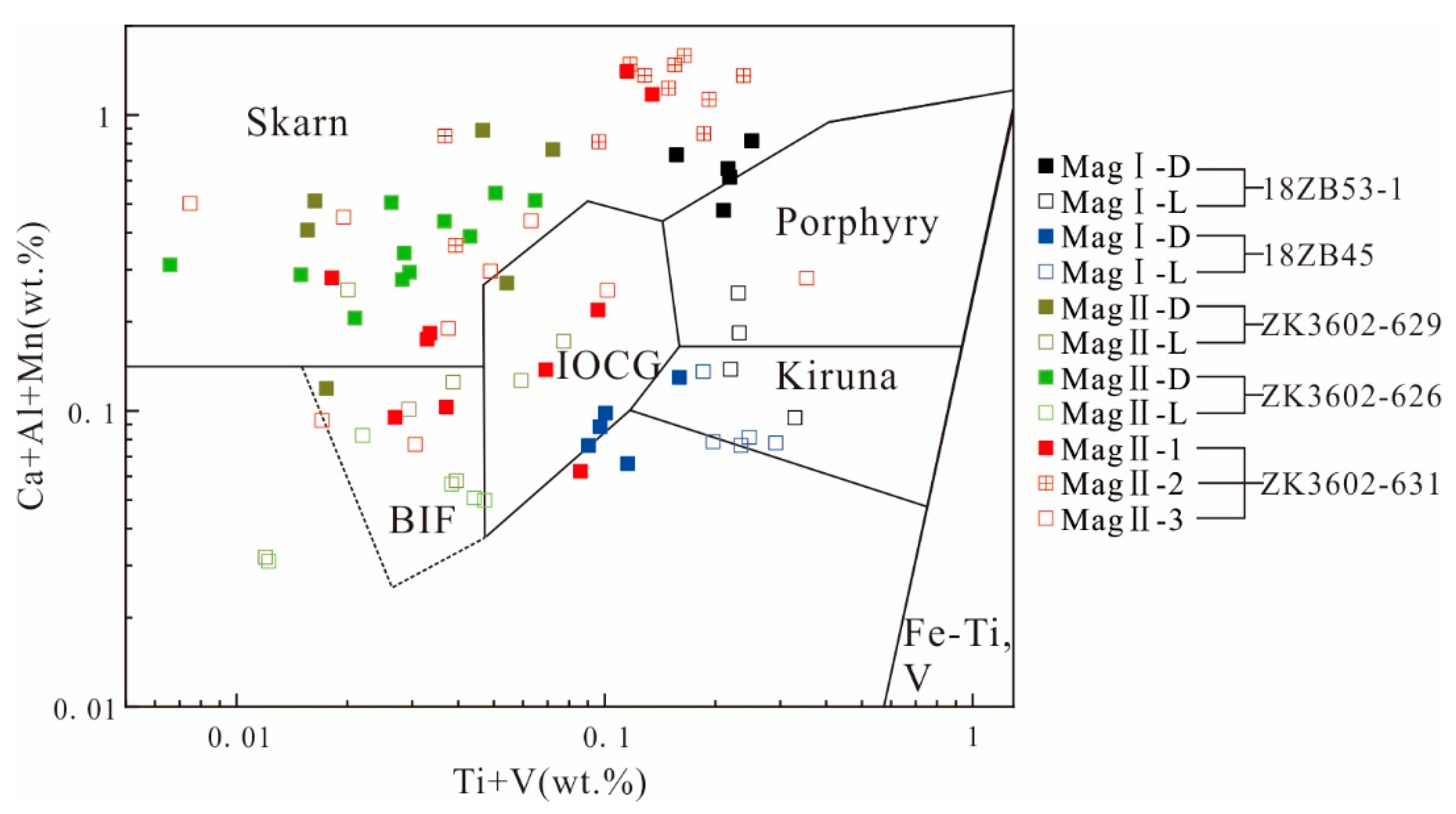
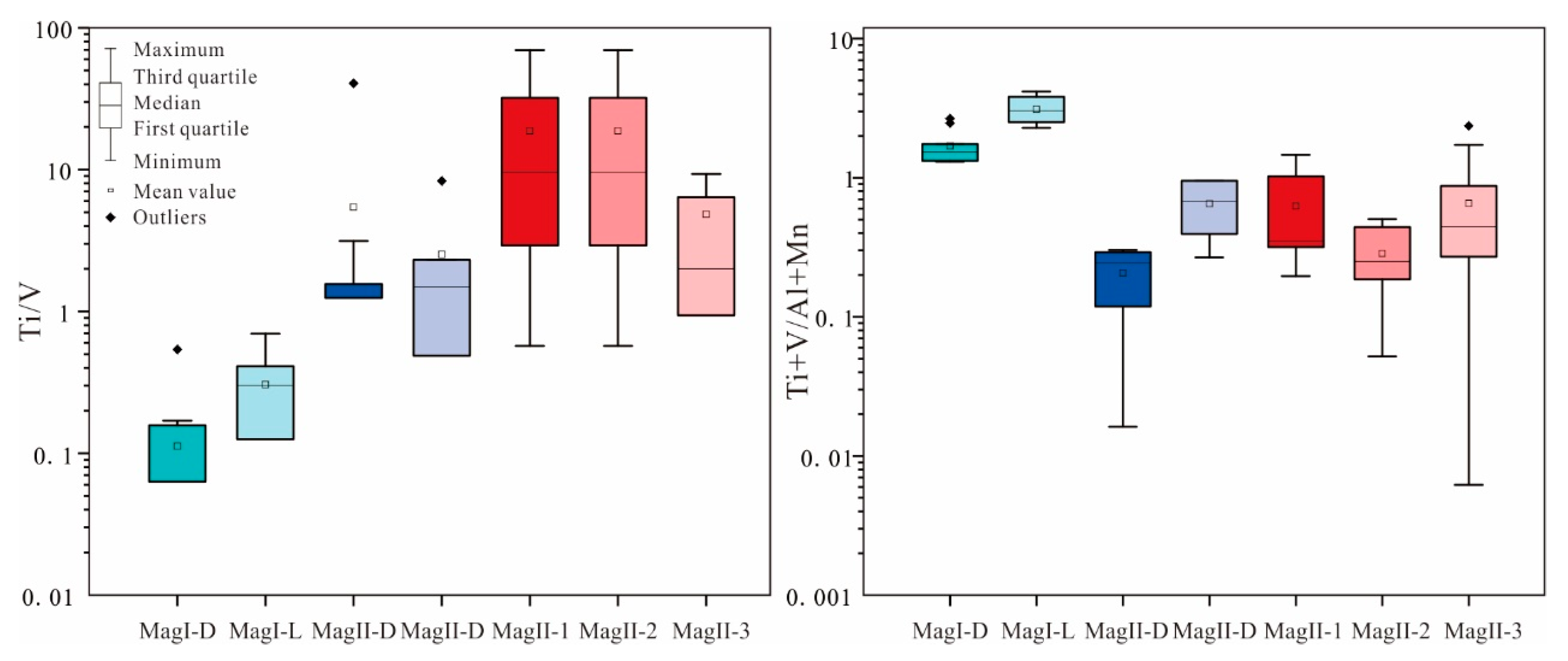
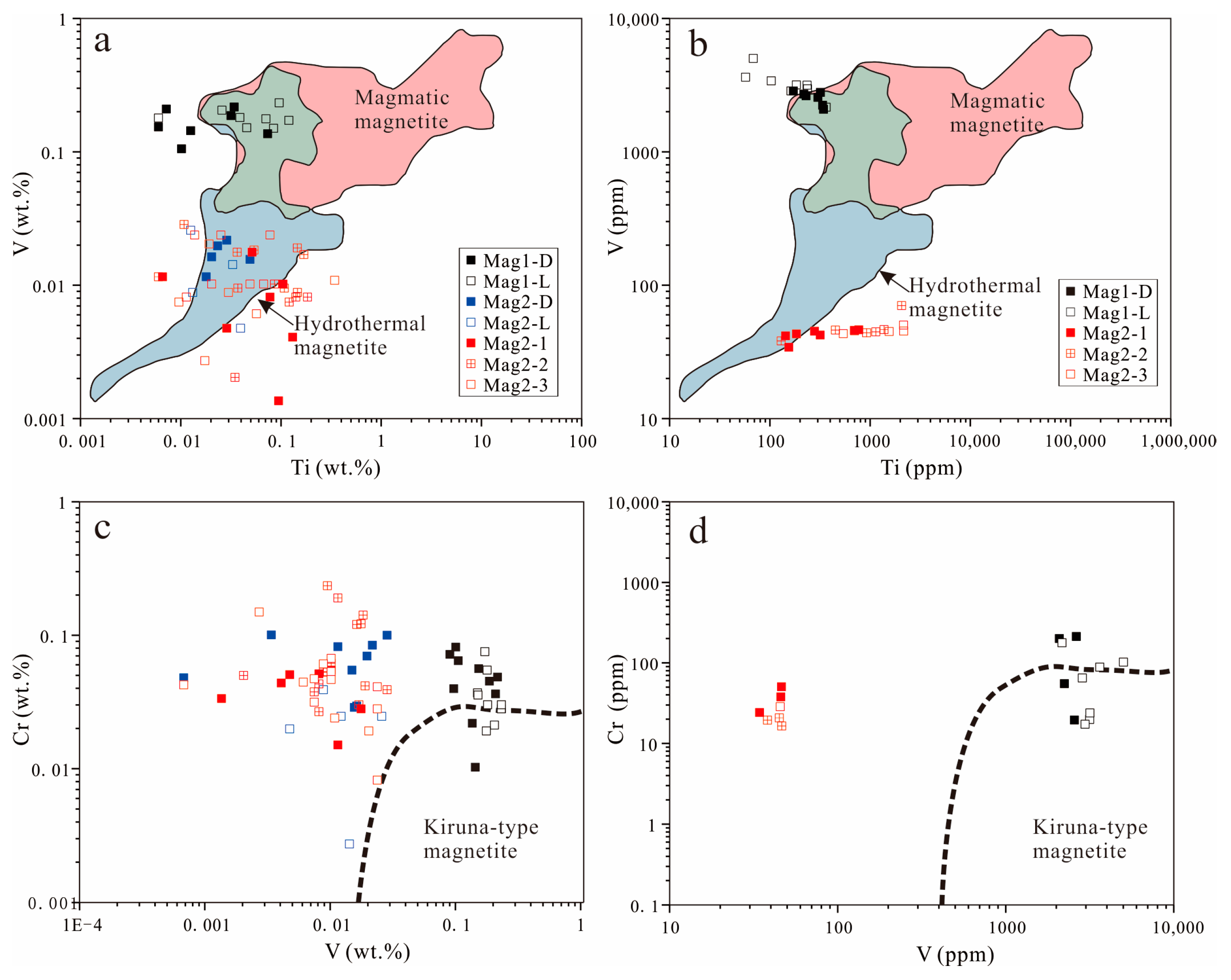
Disclaimer/Publisher’s Note: The statements, opinions and data contained in all publications are solely those of the individual author(s) and contributor(s) and not of MDPI and/or the editor(s). MDPI and/or the editor(s) disclaim responsibility for any injury to people or property resulting from any ideas, methods, instructions or products referred to in the content. |
© 2024 by the authors. Licensee MDPI, Basel, Switzerland. This article is an open access article distributed under the terms and conditions of the Creative Commons Attribution (CC BY) license (https://creativecommons.org/licenses/by/4.0/).
Share and Cite
Wu, Y.; Shen, P.; Feng, H.; Li, C.; Zhao, J.; Luo, Y.; Li, W. Textures and Chemical Compositions of Magnetite from Zhibo Submarine Volcanic Iron Oxide Deposit, Xinjiang, China: Implications for Re-Equilibration Processes. Minerals 2024, 14, 548. https://doi.org/10.3390/min14060548
Wu Y, Shen P, Feng H, Li C, Zhao J, Luo Y, Li W. Textures and Chemical Compositions of Magnetite from Zhibo Submarine Volcanic Iron Oxide Deposit, Xinjiang, China: Implications for Re-Equilibration Processes. Minerals. 2024; 14(6):548. https://doi.org/10.3390/min14060548
Chicago/Turabian StyleWu, Yang, Ping Shen, Haoxuan Feng, Changhao Li, Jiayu Zhao, Yaoqing Luo, and Wenguang Li. 2024. "Textures and Chemical Compositions of Magnetite from Zhibo Submarine Volcanic Iron Oxide Deposit, Xinjiang, China: Implications for Re-Equilibration Processes" Minerals 14, no. 6: 548. https://doi.org/10.3390/min14060548
APA StyleWu, Y., Shen, P., Feng, H., Li, C., Zhao, J., Luo, Y., & Li, W. (2024). Textures and Chemical Compositions of Magnetite from Zhibo Submarine Volcanic Iron Oxide Deposit, Xinjiang, China: Implications for Re-Equilibration Processes. Minerals, 14(6), 548. https://doi.org/10.3390/min14060548




